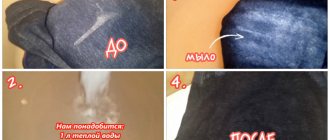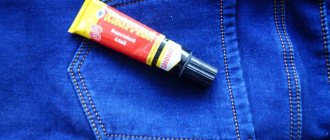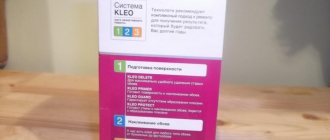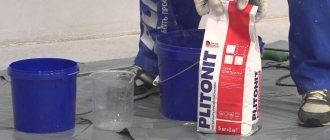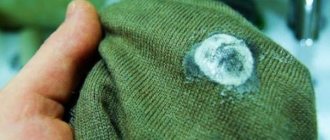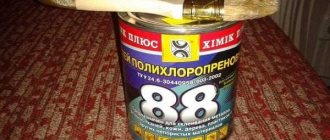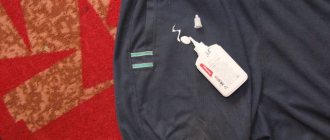The nuances of using different means
The choice of a specific adhesive composition affects the bonding strength of textiles and, in principle, the ability to use this item.
Nowadays, the range of adhesives for textiles and fabrics, which are used to form an adhesive seam on fabrics or decoration items, is diverse.
Let us list the main parameters of such adhesives for fabric and textiles;
- PVA. Versatile, suitable for creative work, especially good for decoupage. They are moisture resistant;
- glue for rubber and latex. Used for leather, foam rubber, fabric products. Due to the lack of damaging effects, it is suitable for delicate objects;
- composition for polyurethane. Suitable for polyvinyl chloride, metal, wood, plastic products;
- nairite (neopropene). Transparent, waterproof. Suitable for fabric, footwear, reliable gluing;
- hot melt adhesive. Absolutely harmless, resistant to water, chemicals, colorless; - perchlorovinyl. Has proven itself in the field of shoe repair, also suitable for rubber, leather, textile products;
- butadiene-styrene. Elastic, resistant to ultraviolet radiation, as well as to high and low temperatures and moisture;
- nitrocellulose. It glues leather products well to fabric surfaces and other various complex types of materials to each other.
Areas of application
A glue stick, pad or spray for temporary fixation does not spoil the thing being glued, therefore it is used in various areas where it is necessary to briefly connect materials.
Cutting and sewing
Cutting fabrics and sewing is much more convenient using a spray for temporary fixation. The tool allows you to quickly perform the following operations:
- Open it up. Fixing stencils or patterns prevents the pattern from moving out.
- Reduced flowability. On fabric with fraying edges, it is more difficult to process seams and buttonholes and sew in zippers. By sprinkling the edges with temporary glue, it is possible to prevent fraying and make the process of processing the edges easier.
- Attaching appliques or lace. Temporary glue will help you check how the decor looks on the clothing and whether it is placed correctly.
- Prevent slipping when sewing.
- Fastening non-adhesive interlining. Necessary to prevent stretching of knitwear or soft wool.
A short-term fabric fixing agent reduces material loss due to flow and speeds up the sewing process.
Needlework
The possibilities for using adhesives are almost limitless. The product is most often used in the following operations:
- Hand or machine embroidery. When, due to the characteristics of the material or the characteristics of the sewn item, it is impossible to use a hoop, glue will help to temporarily fix the fabric. After drying, the evenly sprayed aerosol gives the area of the material at the embroidery site the necessary rigidity. When choosing a composition, you need to pay attention to the stickiness: the substance should not remain on the needle, making it difficult to pass.
- Attaching small components. It is more convenient to attach beads, sequins or other accessories to the base before sewing. This will allow you to evaluate the appearance of the finished product, and, if necessary, make corrections to the design.
- Patchwork. Pre-attaching and then stitching onto the fabric speeds up the creative process.
Temporary glue is often used when working with leather. Short-term attachment of parts makes it possible to produce complex products.
Design of wall newspapers
The paper cleaner briefly fixes the glued piece of paper or paper figurine and allows you to beautifully design the poster. The advantage of such a wall newspaper is that the glued elements can be replaced with new ones.
Room decor
Using decorative components, you can decorate curtains, furniture or walls, changing the design of the room. The decor is attached temporarily; if desired, it can be removed or replaced with another.
Holiday decoration
The product helps to stick posters and other decorations on the walls, creating a festive atmosphere.
After the celebration is over, the decor comes off without damage and can be reused.
First dental aid
Dental crowns and bridges are glued to special cement during prosthetics, ensuring a strong fixation of the structure on the tooth ground for this purpose. But sometimes crowns fall off, and a visit to the dentist is required to put them back in place.
Before visiting the dentist, you can use a special hypoallergenic glue for short-term fixation of crowns. A suitable means for attaching removable dentures will hold the fallen crown for 10-12 hours.
Assembly and minor repairs
A situation familiar to many: when assembling furniture or repairing equipment, you had to look for an assistant to hold small parts. You can do without outside help when working by using temporary fixation glue.
Types of textile glue
Rubber glue.
When choosing an adhesive for fabrics, textiles, and furniture, you should pay attention to proven brands to be sure that they will not damage the material. However, before each specific application, depending on the specific textile, it is worth checking its compatibility with the composition.
Rubber textile adhesive is good for repairing clothes and other products if you need to do the job efficiently without glue stains.
This adhesive agent is a mixture of rubber (natural and synthetic) with vulcanizing substances. It is recommended to take a non-toxic product for rubber and fabric products in small packages.
Textile glue is applied to the parts intended for gluing, and after some time they are connected to each other.
Perchlorovinyl. Perchlorovinyl chloride adhesive for fabrics is a mixture of an organic solvent with a resinous perchlorovinyl compound and a plasticizer.
This product is quite heat-resistant (withstands up to 100 C), resistant to cold (withstands up to -20 C), water, oils, and gasoline. Application is two-stage. The second layer is applied after 10 minutes. The finished item can be used after 48 hours.
Liquid thread adhesive. Very popular when performing creative and handicraft works, when gluing dissimilar materials. It is applied very precisely and evenly, has good adhesive properties, and is completely transparent.
The advantages include fast drying in a few seconds, no damage to the surface as a result of work. Perfect for beginners.
It has proven itself well when gluing fringed objects, appliqués, coconut threads, felt, felt materials, patches, beads, web fabrics and textiles.
Nitrocellulose adhesive for textiles and fabrics. The foundation of the agent is a mixture of nitrocellulose and plasticizers with a solvent.
A popular application is the shoe industry. It is used to work with leather and durable textiles (banner fabric or bolognese). For strong adhesion of surfaces, it is necessary to apply a load to them after the gluing process.
Hot-melt adhesive composition. Available in powder or rod. In the powder form, it must be diluted. When using a stick, it is recommended to melt the adhesive using a special glue gun.
The advantages of textile adhesive include good adhesive properties, environmental safety, strength of the adhesive seam, and the absence of adhesive traces. PVA. The abbreviation stands for polyvinyl acetate glue.
This composition is easily washed off from the fabric, so it is used for both primary and temporary gluing.
Polyvinyl acetate glue does not like water, but new moisture-resistant products are now available. There are also PVA with two components in its composition.
It is able to withstand direct water contact. Polyvinyl acetate adhesive composition is popular in decoupage works, when performing work on the manufacture of fabric crafts.
Aerosol composition. A very convenient adhesive for spraying onto an object, and it can be used over large areas. Adhesive aerosol for textiles differs only in the type of release (the product is in small containers).
It is convenient to use for fixing patterns, sewing on zippers, making bastings, and finishing the edges of textiles. Due to the absence of direct contact of the contents of the can with the air, the glue has a long shelf life.
Tips for working with adhesive bases
It is very easy to join fabrics using adhesive backings. These include non-woven fabric, “gossamer” and dublerin. Manufacturers apply a thin layer of glue to these materials, which is activated upon contact with a hot iron.
Gluing fabric using these materials is extremely simple - carefully level the adhesive fabric, lay it out, arrange the parts that need to be glued, lay the material on top (with the adhesive side to the fabric) and run an iron over it. Most often, this method is used to tuck and glue overlong galoshes on trousers and jeans, to strengthen frayed fabrics, and to prepare children's carnival costumes. When working with self-adhesive tapes, do not turn on the steam mode. When exposed to steam, the material may deteriorate and you will not be able to stick anything.
Recommendations for choosing adhesive
When choosing glue for textiles, it is recommended to study its instructions and description.
Due to the fact that fabric material is a flexible material, subject to deformation and constant washing, the adhesive must be durable and withstand a variety of influences.
Such loads include constant contact with water, chemical detergents, exposure to ultraviolet radiation, ironing, and deformation during washing.
If the glue can cope with all the loads, then it will rightfully be considered high quality.
A good adhesive should have the following characteristics:
- colorlessness and transparency;
- thickness that will not allow the adhesive agent to drain;
- neutral odor, should not be unpleasant;
- resistance to damage and deformation;
- absence of stains as a result of work, especially on the front side of the fabric;
- acceptable hardening time and complete hardening.
Any textile adhesive ideally forms an elastic film, which, in turn, should glue surfaces and create protective functions, maintain proper stretchability without forming a rigid joint.
Superglue is not recommended for use on textile products, since the adhesive seam should not change when the fabric fibers move.
It is recommended to purchase glue based on the type of fabric (silk, synthetic, cotton, leather, wool and others).
If this is necessary, then you can take a universal glue that will suit all fabrics.
Rules for use
Before starting work, you need to clean and dry the base. If it is fabric, it should be clean, smooth (ironed). The glue in the aerosol should be shaken well for 10 seconds and at a distance of 20 cm from the surface, perform the following actions:
- spray the glue onto the material in a thin layer, accurately determining the direction of the stream and not catching unnecessary areas (to do this, turn the sprayer towards the mark made by the manufacturer on the neck);
- if you bring a container of glue close to fabric or other material, the stream will be too concentrated;
- wait 1-2 minutes, then lean the part, stencil, applique or other product against the main surface, press firmly, preventing glue from leaking and moving the part;
- You should not apply glue to the second surface; it is enough to cover only one side of the joint;
- You can glue the elements an unlimited number of times - the mass will be sticky until it hardens.
When working with glue yourself, you need to pay attention to safety measures. Aerosols are highly flammable, so any actions with them should be carried out away from sources of fire. Do not store the product in such a way that it is not exposed to sunlight, as the glue may deteriorate. You need to work in a well-ventilated area, wearing a respirator. This will help prevent inhalation of glue vapors and the entry of tiny sprayed particles into the lungs. If glue drips onto the skin, it should be washed under cool water and soap. In case of contact with eyes, in addition to rinsing, you should consult a doctor!
Glue companies and prices
A cheap adhesive composition for textiles costs a maximum of 100 rubles for a small bottle or small tube.
Foreign formulations and well-known Russian brands are usually more expensive. Prices vary from 130 to 200 rubles.
We list the most famous brands of adhesive composition.
- "Guterman." Perfect for felt, denim, linen, cotton products, and also good for finishing the reverse side of embroidery for subsequent gluing. Due to the absence of solvents, it is suitable for dry cleaning and washing. Can be removed with water immediately after use. The price of such a product is around 300 rubles.
- "Decola". Despite its density and density, it is not diluted, as it loses its characteristics. It perfectly glues surfaces of different structures, despite the inconvenient application. Good for working with applications. The price of such textile glue is around 150 rubles.
- Mod Podge Fabric. Withstands hand washing and non-aggressive detergents. The application provides a glossy, attractive finish that protects textiles from damaging factors. The price of such a product is around 250 rubles.
- "JAVANA". The use of glue ensures the formation of a matte coating, which is additionally secured by ironing. It has proven itself to be an excellent material for working with thin napkins and decoupage. The price is around 300 rubles.
- UHU Textile. Perfect for many types of fabrics, therefore it is universal. It is water resistant, resistant to ironing and listening to the battery. The price is around 250 rubles.
- "Second". In addition to use on textiles, it is acceptable for leather, ceramic, porcelain, and foam products. Rightfully refers to a universal agent. It hardens very quickly, so it should be used promptly. The price is around 100 rubles.
If we talk about gluing rhinestones, then it is necessary to use adhesives specialized for this, which are capable of gluing the material efficiently and reliably, thereby ensuring an attractive appearance.
For these purposes use:
- "Moment Crystal". Colorless, transparent, convenient and easy to apply, dries instantly to form a film. It is used very sparingly, just a small drop will stick the rhinestone. But it should be borne in mind that due to instant drying, correcting the position of the object will be problematic. The price is around 70 rubles.
- "Fevicryl". The composition contains epoxy resin, so the glue is resistant to water after drying. It has a dosed spout, very convenient to squeeze out. The white color of the agent changes to colorless after drying. The price is around 200 rubles.
- "E 6000". The Chinese composition of a viscous consistency, without color, is quite elastic and plastic. Excellent adhesive properties to many surfaces. Well suited for rhinestones with an inner foil side. The price is around 100 rubles.
How to make glue yourself
Craftsmen and crafters often choose the good and well-known Mod Podge Fabric composition. The big disadvantage of glue is its high cost, and it is not used economically.
In practice, they use methods for making adhesives with their own hands. Let us describe two such methods.
In the first option, first prepare a container, for example, a jar with a lid with a capacity of more than 400 ml. It needs to be washed and dried.
After this, mix 225 ml of polyvinyl acetate glue with 112.5 ml of water in a container and mix thoroughly. Instead of PVA, adhesive material for scrapbooking is suitable, but acid-free.
Next add 2 tbsp. acrylic or water-based varnish and, if desired, 2 tbsp. sequin. Stir and store in a cool place with the lid on.
For the second option, the first thing you need to do is prepare a container of the same volume. Mix 210 g of sifted flour, 56 g of sugar, 225 ml of water.
Stir until there are no lumps of flour. Heat the mixture over a fire, but do not bring it to a boil.
The consistency should not be thick, otherwise you need to add water. At the end of cooking, add 1/4 tsp. vegetable oil. Next, stop heating and add 1/4 tsp of vinegar.
Store the cooled product in a cool place with the lid closed. You can make your own dextrin fabric adhesive agent.
Dextrin is prepared by frying the starch in the oven at 160 C for about two hours. In a ratio of 1 to 1, boiling water is added to the starch until the dextrin is completely dissolved.
It is recommended to use the product immediately due to its rapid drying. You can also try making casein glue. To do this, you need to combine powdered casein with water in a ratio of 2 to 1. Next, heat the mass until smooth, but do not boil.
Powdered casein is sold in many stores, its price is inexpensive, but the glue obtained in this way hardens very quickly. Therefore, it is recommended to do the work immediately and make small amounts of glue.
